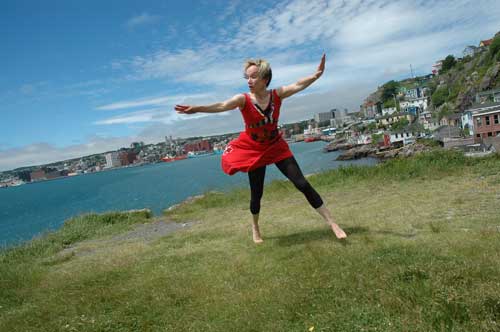In the grey drizzle of a typical January on the West Coast, Victoria’s three best-known choreographers each took thirty minutes to prove that modern dance likes to tell stories just as much as classical ballet does.
The evening opened with “The Handless Maiden”, choreographed by Constance Cooke and danced by Jung-ah Chung. Originally performed at Vancouver’s Dancing on the Edge Festival in 2002, the work is loosely based on a folktale about a poor miller who promises the devil whatever lies behind his mill in exchange for gold. The miller thinks he has given away an apple tree, but in fact he has promised his daughter. The girl fights the devil off, but at the expense of her own hands, which are then strapped to her back. She makes her way to a king’s garden, where a prince finds her and has a new pair of hands made for her out of silver. The hands are beautiful, but useless. Her real hands are magically restored only after she risks her own life to save her child’s.
Cooke’s version opens with Chung folded over, wrists bound behind her back, hands useless stumps. She is confined and constrained; she can rise to her knees, but no further; we see her back but she can’t quite turn fully to face us. In the next section, she has silver, long-fingered hands (a little too like Johnny Depp’s in “Edward Scissorhands” for comfort) and can stand and move, but the hands are still useless and she is still constrained. Only in the last segment, with her hands fully restored, is the maiden truly free.
Jung-ah Chung is exquisite. Her body and face radiate commitment and emotion, and she makes what could be a difficult piece for an audience to interpret (if you don’t know the story, the program notes won’t help) into something that’s still murky, but gorgeous to watch. Cooke uses the fairytale, she says, to explore “the mythology of the feminine unconscious”, but in the process leaves perhaps too much of the literal story intact — she needs either to truly tell the tale, or move fully into pure metaphor.
“The Suffragettes”, by Denise Lieutaghi, also tells a story, this time of the women who fought for their right to vote. It begins with three dancers (Brandy Baybutt, Tiffany Loney and Lisa Bernstein) in vaguely Victorian dresses on a revolving pedestal, like perfect ballerinas on a music box. The dancers soon come down to earth, however, begin to shed their virginal white and both dance and speak their minds. The blend of movement and spoken word (including actual recordings of suffragette leaders and the male politicians who opposed them) reinforces Lieutaghi’s point, and works particularly well when, for example, the dancers themselves repeat that “women are citizens of the world”, and it gradually transforms into “women sit”.
There were other great bits, too, including hooped skirts that become cages, and good doses of comedy on top of the political commentary. Ultimately, however, the piece did not quite come together as a whole. Again, it started with a narrative thread that pulled us in one direction, but then set us loose to wander.
Lynda Raino’s “Two” ended the evening on a giggly high note. Performed by Brandy Baybutt, Karen Avery, Jessica Kwong and Neely Carbone, “Two” is the story of four children, three two-year-olds and one a little younger, still in a sleeper, simply doing what they do best — and it’s just plain brilliant. Raino and her dancers capture with amazing accuracy just how children look and move and behave.
In the space of thirty minutes, we come to know each toddler remarkably well. There is the bully boy and the girly girl, the one whose t-shirt will just never stay down over his belly, and the fat baby who takes being poked and prodded, whacked over the head and bossed around with remarkable equanimity. As Raino states in the program: “Amazing that we all survived our childhoods”.
Local artist Carol Rae designed the perfectly-in-proportion costumes that include oversized, soft-sculpture heads built over hockey helmets (the problem, she says, was finding a way for the dancers to breath and see, climb a high chair and tumble across the stage, without dying of heat exhaustion), and even — as the audience was delighted to discover when the bully boy takes his clothes off and the others quickly follow — anatomically correct dangly bits. The baby is shocked when she realizes that she doesn’t look quite the same as the boys. This piece should be mounted again, and often.
Tagged: Contemporary, Performance, BC , Victoria





